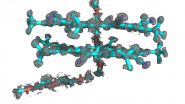Using a dense time series of satellite images and air photos, Odin Marc and colleague reconstructed the history of landsliding in four mountain areas hit by large, shallow earthquakes. Their reconstructions show that the rate of landsliding caused by rainfall is systematically elevated after an earthquake, up to 20-fold, and then recovers over a period of months to years.
The magnitude of this response and the duration of the recovery phase are possibly related to the size of the earthquake. Ruling out other mechanisms, Marc and colleagues found evidence suggesting that heightened landslide rates and their gradual decrease are due to shaking-induced damage of rocks very near Earth's surface and active healing processes.
These findings show that in mountain areas intensely shaken by large earthquakes, people should reckon with higher than normal landslide risks during the recovery and rebuilding phase. This risk can be anticipated and monitored and rates of mass wasting are likely to return to pre-earthquake levels eventually.
FEATURED ARTICLE Transient changes of landslide rates after earthquakes
Odin Marc, et al., Helmholtz Centre Potsdam, German Research Center for Geosciences (GFZ), Telegraf-enberg, 14473 Potsdam, Germany. Published online ahead of print on 21 Aug. 2015; http://dx.doi.org/10.1130/G36961.1.
Other recently posted GEOLOGY articles are highlighted below:
Mantle strength of the San Andreas fault system and the role of mantle-crust feedbacks
Vasileios Chatzaras et al., Dept. of Geoscience, University of Wisconsin, Madison, Wisconsin, USA. Published online ahead of print on 21 August 2015; http://dx.doi.org/10.1130/G36752.1.
What governs the cycle of earthquakes that occur on large strike-slip faults, including the San Andreas fault system of western California? Strike-slip faults, which result in horizontal motion, are thought to continue downward through the entire tectonic plate. Consequently, there is a debate about which part of the tectonic plate controls deformation: Is it the upper crust that contains discrete faults or the upper mantle where distributed flow occurs in shear zones? Vasileios Chatzaras and colleagues provide the first direct evidence for the strength of the San Andreas fault system at depth, by using samples of mantle rock brought up along the Calaveras fault during volcanic eruptions. These "mantle xenoliths" have low water contents and record shear stresses that are nearly identical to the low crustal strength of the strike-slip faults. To explain these observations, the authors propose the "lithospheric feedback" model, in which the behavior of the San Andreas fault system is controlled by the interaction of the faulting upper crust and flowing upper mantle acting as an integrated system. The interaction of the lithospheric layers -- rather than their relative strengths -- may be the critical driver of the seismic cycle within the San Andreas fault system.
Carbon sequestration on Mars
Christopher S. Edwards California Institute of Technology, Pasadena, California, USA; and Bethany L. Ehlmann, Jet Propulsion Laboratory, California Institute of Technology, Pasadena, California, USA. Published online ahead of print on 21 Aug. 2015; http://dx.doi.org/10.1130/G36983.1.
On Earth, carbon sequestration plays an important role in the carbon cycle, scrubbing out atmospheric CO2 for long-term storage as carbonate minerals in rocks. On Mars, carbonate is identified in very low abundances within the dust and soils and in meteorites, but only one large, well-exposed carbonate-bearing rock unit has been identified to date, the Nili Fossae plains (~6800 square kilometers [~2600 square miles]). Christopher Edwards and Bethany Ehlmann studied this area to evaluate the timing and carbon sequestration potential of rocks on Mars; they found that the carbonate was generated by alteration of olivine-enriched basalts and that these rocks hold at most ~20% carbonate. This translates to the sequestration of only a few millibars of atmospheric CO2. While significant compared to the modern thin Martian atmosphere (~6 milibars), the lack of any additional, comparably sized carbonate-bearing deposits indicates ineffective carbon sequestration in Martian rock units over the past ~3.7 billion years. This implies either (1) a thin atmosphere, and thus likely cold conditions during widespread valley network formation by surface waters, extensive post-Noachian atmospheric loss to space; or (2) diffuse, deep sequestration by a yet-to-be understood process. Mars' crust:atmosphere carbon reservoir ratio is a mere ~10 to 103, in stark contrast to Earth's ratio of ~104 to 105, which is driven largely by biology.
Episodic overbank deposition as a dominant mechanism of floodplain and delta-plain aggradation
Zhixiong Shen et al., Dept. of Earth and Environmental Sciences, Tulane University, New Orleans, Louisiana, USA. Published online ahead of print on 21 Aug. 2015; http://dx.doi.org/10.1130/G36847.1.
The commonly thick deposits from rivers and deltas offer a rich source of information about surface processes during a large part of Earth's history. The traditional view is that a large proportion of these deposits accumulate relatively gradually in association with frequent floods. However, this has never been firmly demonstrated due to the difficulty to date such sediments. Using state-of-the-art dating methods, we show that sedimentation in the Mississippi Delta is dominantly episodic over centennial to millennial timescales, which has implications for the interpretation of the continental rock record. Sediment accretion in the Mississippi Delta can reach remarkably high rates of 1 to 4 centimeters per year that can persist for centuries.
Are the large filamentous microfossils preserved in Messinian gypsum colorless sulfide-oxidizing bacteria?
Francesco Dela Pierre et al., Dipartimento di Scienze della Terra, Università di Torino, 10125 Torino, Italy. Published online ahead of print on 21 Aug. 2015; http://dx.doi.org/10.1130/G37018.1.
Francesco Dela Pierre and colleagues provide a detailed study of the large filamentous microfossils preserved in the Late Miocene gypsum from Northern Italy, deposited during the early stage of the Messinian salinity crisis (MSC). This study demonstrates that these filaments represent remains of colorless, vacuolated sulfide-oxidizing bacteria. The assignment of the Messinian filaments to this group of bacteria indicates that gypsum formed at greater water depth than previously suggested, based on the assumption that the filaments represent benthic phototrophs. In addition to filamentous fossils, the studied gypsum crystals contain remains of euryhaline and stenohaline diatoms and clay-rich aggregates that correspond to alteration products of marine snow floccules. This peculiar fossil assemblage reflects condition of increased productivity in the water column that was triggered by high influx of nutrients into the basin during phases of enhanced freshwater discharge. This scenario is in agreement with recent work, which confirms that the early stages of the MSC were typified by algal blooms caused by eutrophication. The algal blooms enhanced organic matter degradation by bacterial sulfate reduction in an oxygen-depleted sedimentary environment; this provided the high hydrogen sulfide flux required for the growth of colorless sulfur bacteria.
Antarctic microbial mats: A modern analog for Archean lacustrine oxygen oases
Dawn Y. Sumner et al., Dept. of Earth and Planetary Sciences, University of California, Davis, California, USA. Published online ahead of print on 21 Aug. 2015; http://dx.doi.org/10.1130/G36966.1.
The evolution of oxygenic photosynthesis was the most important geochemical event in Earth history, causing the Great Oxidation Event (GOE) approx. 2.4 billion years (b.y.) ago. However, evidence is mixed as to whether O2 production occurred locally as much as 2.8 b.y. ago, creating O2 oases, or initiated just prior to the GOE. The biogeochemical dynamics of possible O2 oases have been poorly constrained due to the absence of modern analogs. However, cyanobacteria in microbial mats in a perennially anoxic region of Lake Fryxell, Antarctica, create a 1 to 2 mm O2-containing layer in the upper mat during summer, providing the first known modern analog for formation of benthic O2 oases. In Lake Fryxell, benthic cyanobacteria are present below the oxycline in the lake. Mat photosynthesis rates were slow due to low photon flux rate (1 to 2 μmol m-2 s-1) under thick ice cover, but photosynthetic O2 production was sufficient to sustain up to 50 μmol O2 L-1, sandwiched between anoxic overlying water and anoxic sediments. Dawn Sumner and colleagues hypothesize that Archean cyanobacteria could have similarly created O2 oases in benthic mats prior to the GOE. Analogous mats may have been at least partly responsible for geological evidence of oxidative weathering prior to the GOE, and habitats such as Lake Fryxell provide natural laboratories where the impact of benthic O2 oases on biogeochemical signatures can be investigated.
Oxygen isotope mass-balance constraints on Pliocene sea level and East Antarctic Ice Sheet stability
Matthew J. Winnick and Jeremy K. Caves, Dept. of Earth System Science, Stanford University, 473 Via Ortega, Room 140, Stanford, California 94305, USA. Published online ahead of print on 21 Aug. 2015; http://dx.doi.org/10.1130/G36999.1.
During the mid-Pliocene warm period (3.3-2.9 million years ago), atmospheric pCO2 levels were similar to modern, and global temperatures were 2-3 degrees C warmer than modern. As such, this time period allows insights into global sea level rise and terrestrial ice sheet extent under near-modern radiative forcing conditions. Previous studies suggest that Pliocene sea level was up to 30 m above modern based on oxygen isotopes recorded in benthic foraminifera, necessitating the deglaciation of Greenland, West Antarctica, and a significant portion of East Antarctica. In this study, Matthew Winnick and Jeremy Caves present the first mass balance model of oxygen isotopes in the global ocean-ice system and revisit estimates of Pliocene sea level. This model incorporates a previously neglected effect: the isotopic evolution of terrestrial ice with changing climate. Under warmer Pliocene temperatures, the isotopic value (delta-18O) of Antarctic ice was likely higher than modern, resulting in a lower delta-18O value of the Pliocene ocean. Incorporating this effect, Winnick and Caves estimate that Pliocene sea level was likely 9-13 m and very likely 5-17 m above modern. These reduced estimates suggest that the East Antarctic ice sheet is much less sensitive to CO2 increases than previously inferred from the geologic record.
Precambrian reidite discovered in shocked zircon from the Stac Fada impactite, Scotland
S.M. Reddy, Dept. of Applied Geology, Institute for Geoscience Research (TIGeR), Curtin University, GPO Box U1987, Perth, WA 6845, Australia. Published online ahead of print on 21 Aug. 2015; http://dx.doi.org/10.1130/G37066.1.
Terrestrial impact events have had a profound influence on Earth's geological, geochemical, and biological evolution. However, the record of Precambrian impacts is poorly constrained due to the dynamic nature of plate tectonics, erosion, and deposition of younger rocks that may destroy or cover the evidence. Here, S.M. Reddy and colleagues report the first Precambrian occurrence of the rare mineral reidite (ZrSiO4) within grains of shocked zircon in the ca. 1.18 Ga Stac Fada Member (Stoer Group), northwestern Scotland. The reidite, preserved as less than two-micron-wide lamellae, is unambiguous evidence of shock pressures in excess of ~30 GPa and confirms the impact origin for the Stac Fada deposit. The reidite lamellae are locally deformed, and sites of deformation record its decomposition to baddeleyite (ZrO2) and amorphous silica, the first natural example of this transformation. The findings demonstrate that reidite and baddeleyite may form and be transported in high-energy ejecta without physical or chemical breakdown and are stable during sedimentary diagenesis and low-grade metamorphism. Thus, reidite may be preserved over time scales exceeding one billion years establishing the use of reidite within detrital shocked zircon from Precambrian strata as a viable and valuable means of recognizing and characterizing ancient terrestrial impact events.
Direct stratigraphic dating of India-Asia collision onset at the Selandian (middle Paleocene, 59 +/- 1 Ma)
Xiumian Hu et al., State Key Laboratory of Mineral Deposit Research, School of Earth Sciences and Engi-neering, Nanjing University, Nanjing 210023, China. Published online ahead of print on 21 Aug. 2015; http://dx.doi.org/10.1130/G36872.1.
The most important event in recent geological history, which led to the birth of the Himalayan Range and modified profoundly oceanic and atmospheric circulation and faunal distribution on our planet, has finally been dated with precision. This was accomplished by a team of sedimentologists and paleontologists from China, Italy and the U.S., who determined the age of zircon grains and fossils contained in sediments exposed in Tibet close to the tectonic boundary between the Indian and Asian Plates. Exactly when India -- once attached to Africa as part of Gondwanaland and separated from Eurasia by the vast Neotethys Ocean -- collided with Asia has remained a hotly debated topic among geologists for decades. This study assesses with integrated chronostratigraphic techniques the precise moment when sediments derived from the Asian volcanic margin started to be deposited on the external edge of the Indian continental margin. These sediments contain zircon grains crystallized 58.1 plus or minus 0.9 million years ago, and thus cannot be older than that age. Intercalated strata contain planktonic faunas and floras of Selandian age (i.e., comprised between 61-60 and 58-59 million years ago). These combined ages tell us that the India-Asia collision began 59 plus or minus 1 million years ago.
Crystallization of platinum-group minerals from silicate melts: Evidence from Cr-spinel-hosted inclusions in volcanic rocks
Vadim S. Kamenetsky et al., School of Physical Sciences, University of Tasmania, Hobart, TAS 7001, Australia. Published online ahead of print on 21 Aug. 2015; http://dx.doi.org/10.1130/G37052.1.
This study of platinum-group minerals included in Cr-spinel phenocrysts from high-temperature magmas in continental and island-arc setting presents an unambiguous evidence for precipitation of Pt-Fe and Os-Ir alloys directly from a variety of silicate melts. Vadim S. Kamenetsky and colleagues recorded unique snapshots of magma saturation in alloys of Os-Ir and Pt-Fe at different temperatures and fugacity of oxygen and sulfur. This will provide important information on the behavior of platinum-group elements during mantle melting and primitive magma differentiation, as well as the petrogenesis of cumulate rocks containing platinum-group minerals, implications for placer deposits and Re-Os geochemical systematics. The platinum-group elements appear to be incompatible during mantle melting and compatible during magma cooling and crystallization.
INFORMATION:
GEOLOGY articles published online ahead of print can be accessed online at http://geology.gsapubs.org/content/early/recent. All abstracts are open-access at http://geology.gsapubs.org/; representatives of the media may obtain complimentary articles by contacting Kea Giles at the address above.
Please discuss articles of interest with the authors before publishing stories on their work, and please make reference to GEOLOGY in articles published. Contact Kea Giles for additional information or assistance.
Non-media requests for articles may be directed to GSA Sales and Service, gsaservice@geosociety.org.




